Detailed Network Design Analysis for AusEd IT Infrastructure
VerifiedAdded on 2021/05/31
|11
|2463
|75
Report
AI Summary
This report provides a detailed analysis of the IT infrastructure network design for AusEd, an educational institution with approximately 2000 students and 100 staff members. The project focuses on designing a flexible, resilient, and manageable network to support various applications, including an accounting system using MYOB software, customer relationship management with Sugar CRM, and email services via MS Exchange Server 2007. The report outlines the purpose and scope of the project, emphasizing the need for a scalable network design that can accommodate future growth and ensure easy troubleshooting. It details the equipment used, including fiber cables, scalable switches, routers, wireless access points, servers (DHCP, mail, file, and DNS), access devices, and security devices (firewalls and VPNs). The report uses a three-layered hierarchical network model to illustrate the network design, including core, distribution, and access layers. It also provides a cost analysis of the hardware and justifies the selection of Cisco switches and routers due to their reliability, manageability, scalability, and interoperability. The report concludes by emphasizing the importance of a well-designed network for AusEd's sustainable economic growth and smooth implementation across all its branches.
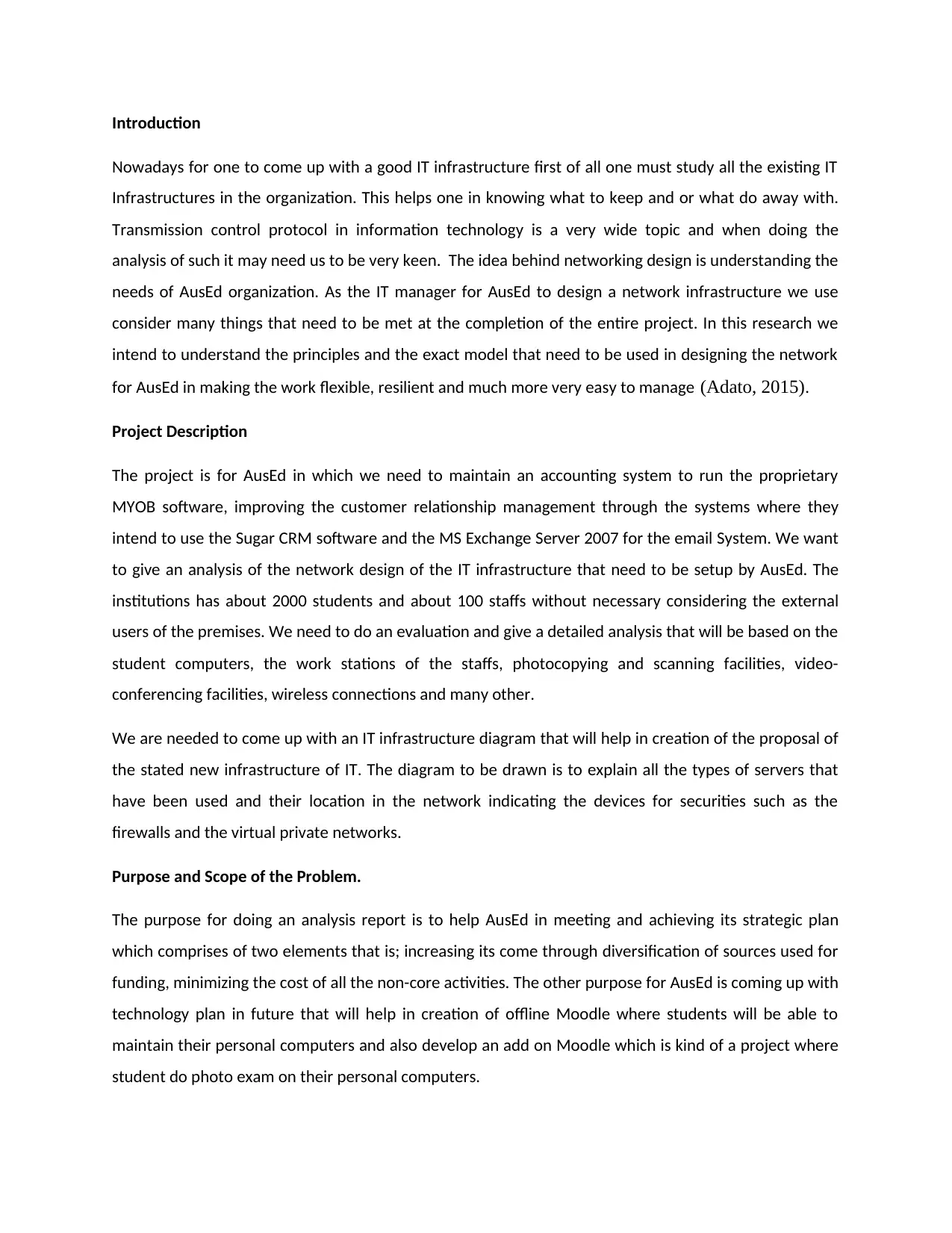
Introduction
Nowadays for one to come up with a good IT infrastructure first of all one must study all the existing IT
Infrastructures in the organization. This helps one in knowing what to keep and or what do away with.
Transmission control protocol in information technology is a very wide topic and when doing the
analysis of such it may need us to be very keen. The idea behind networking design is understanding the
needs of AusEd organization. As the IT manager for AusEd to design a network infrastructure we use
consider many things that need to be met at the completion of the entire project. In this research we
intend to understand the principles and the exact model that need to be used in designing the network
for AusEd in making the work flexible, resilient and much more very easy to manage (Adato, 2015).
Project Description
The project is for AusEd in which we need to maintain an accounting system to run the proprietary
MYOB software, improving the customer relationship management through the systems where they
intend to use the Sugar CRM software and the MS Exchange Server 2007 for the email System. We want
to give an analysis of the network design of the IT infrastructure that need to be setup by AusEd. The
institutions has about 2000 students and about 100 staffs without necessary considering the external
users of the premises. We need to do an evaluation and give a detailed analysis that will be based on the
student computers, the work stations of the staffs, photocopying and scanning facilities, video-
conferencing facilities, wireless connections and many other.
We are needed to come up with an IT infrastructure diagram that will help in creation of the proposal of
the stated new infrastructure of IT. The diagram to be drawn is to explain all the types of servers that
have been used and their location in the network indicating the devices for securities such as the
firewalls and the virtual private networks.
Purpose and Scope of the Problem.
The purpose for doing an analysis report is to help AusEd in meeting and achieving its strategic plan
which comprises of two elements that is; increasing its come through diversification of sources used for
funding, minimizing the cost of all the non-core activities. The other purpose for AusEd is coming up with
technology plan in future that will help in creation of offline Moodle where students will be able to
maintain their personal computers and also develop an add on Moodle which is kind of a project where
student do photo exam on their personal computers.
Nowadays for one to come up with a good IT infrastructure first of all one must study all the existing IT
Infrastructures in the organization. This helps one in knowing what to keep and or what do away with.
Transmission control protocol in information technology is a very wide topic and when doing the
analysis of such it may need us to be very keen. The idea behind networking design is understanding the
needs of AusEd organization. As the IT manager for AusEd to design a network infrastructure we use
consider many things that need to be met at the completion of the entire project. In this research we
intend to understand the principles and the exact model that need to be used in designing the network
for AusEd in making the work flexible, resilient and much more very easy to manage (Adato, 2015).
Project Description
The project is for AusEd in which we need to maintain an accounting system to run the proprietary
MYOB software, improving the customer relationship management through the systems where they
intend to use the Sugar CRM software and the MS Exchange Server 2007 for the email System. We want
to give an analysis of the network design of the IT infrastructure that need to be setup by AusEd. The
institutions has about 2000 students and about 100 staffs without necessary considering the external
users of the premises. We need to do an evaluation and give a detailed analysis that will be based on the
student computers, the work stations of the staffs, photocopying and scanning facilities, video-
conferencing facilities, wireless connections and many other.
We are needed to come up with an IT infrastructure diagram that will help in creation of the proposal of
the stated new infrastructure of IT. The diagram to be drawn is to explain all the types of servers that
have been used and their location in the network indicating the devices for securities such as the
firewalls and the virtual private networks.
Purpose and Scope of the Problem.
The purpose for doing an analysis report is to help AusEd in meeting and achieving its strategic plan
which comprises of two elements that is; increasing its come through diversification of sources used for
funding, minimizing the cost of all the non-core activities. The other purpose for AusEd is coming up with
technology plan in future that will help in creation of offline Moodle where students will be able to
maintain their personal computers and also develop an add on Moodle which is kind of a project where
student do photo exam on their personal computers.
Paraphrase This Document
Need a fresh take? Get an instant paraphrase of this document with our AI Paraphraser
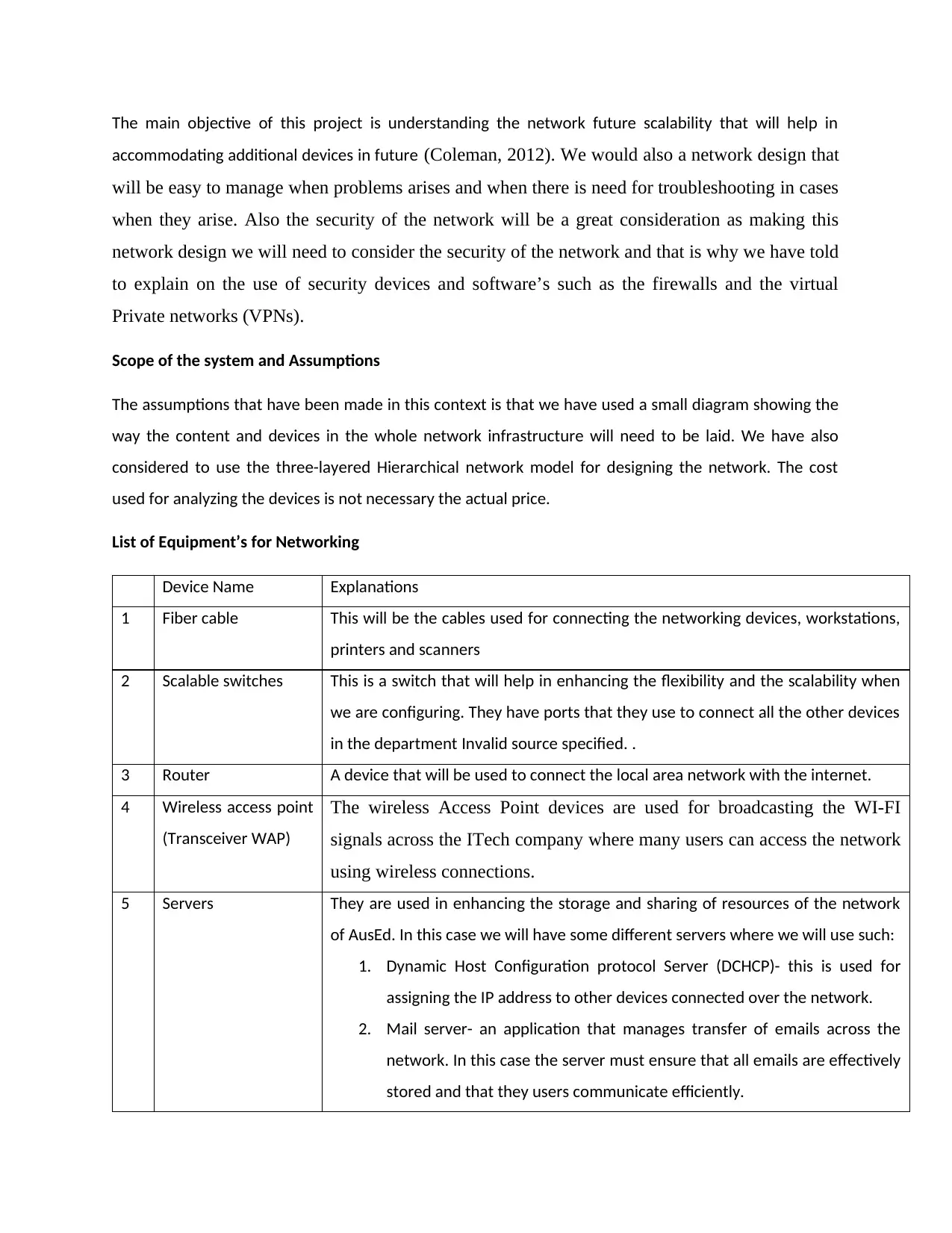
The main objective of this project is understanding the network future scalability that will help in
accommodating additional devices in future (Coleman, 2012). We would also a network design that
will be easy to manage when problems arises and when there is need for troubleshooting in cases
when they arise. Also the security of the network will be a great consideration as making this
network design we will need to consider the security of the network and that is why we have told
to explain on the use of security devices and software’s such as the firewalls and the virtual
Private networks (VPNs).
Scope of the system and Assumptions
The assumptions that have been made in this context is that we have used a small diagram showing the
way the content and devices in the whole network infrastructure will need to be laid. We have also
considered to use the three-layered Hierarchical network model for designing the network. The cost
used for analyzing the devices is not necessary the actual price.
List of Equipment’s for Networking
Device Name Explanations
1 Fiber cable This will be the cables used for connecting the networking devices, workstations,
printers and scanners
2 Scalable switches This is a switch that will help in enhancing the flexibility and the scalability when
we are configuring. They have ports that they use to connect all the other devices
in the department Invalid source specified. .
3 Router A device that will be used to connect the local area network with the internet.
4 Wireless access point
(Transceiver WAP)
The wireless Access Point devices are used for broadcasting the WI-FI
signals across the ITech company where many users can access the network
using wireless connections.
5 Servers They are used in enhancing the storage and sharing of resources of the network
of AusEd. In this case we will have some different servers where we will use such:
1. Dynamic Host Configuration protocol Server (DCHCP)- this is used for
assigning the IP address to other devices connected over the network.
2. Mail server- an application that manages transfer of emails across the
network. In this case the server must ensure that all emails are effectively
stored and that they users communicate efficiently.
accommodating additional devices in future (Coleman, 2012). We would also a network design that
will be easy to manage when problems arises and when there is need for troubleshooting in cases
when they arise. Also the security of the network will be a great consideration as making this
network design we will need to consider the security of the network and that is why we have told
to explain on the use of security devices and software’s such as the firewalls and the virtual
Private networks (VPNs).
Scope of the system and Assumptions
The assumptions that have been made in this context is that we have used a small diagram showing the
way the content and devices in the whole network infrastructure will need to be laid. We have also
considered to use the three-layered Hierarchical network model for designing the network. The cost
used for analyzing the devices is not necessary the actual price.
List of Equipment’s for Networking
Device Name Explanations
1 Fiber cable This will be the cables used for connecting the networking devices, workstations,
printers and scanners
2 Scalable switches This is a switch that will help in enhancing the flexibility and the scalability when
we are configuring. They have ports that they use to connect all the other devices
in the department Invalid source specified. .
3 Router A device that will be used to connect the local area network with the internet.
4 Wireless access point
(Transceiver WAP)
The wireless Access Point devices are used for broadcasting the WI-FI
signals across the ITech company where many users can access the network
using wireless connections.
5 Servers They are used in enhancing the storage and sharing of resources of the network
of AusEd. In this case we will have some different servers where we will use such:
1. Dynamic Host Configuration protocol Server (DCHCP)- this is used for
assigning the IP address to other devices connected over the network.
2. Mail server- an application that manages transfer of emails across the
network. In this case the server must ensure that all emails are effectively
stored and that they users communicate efficiently.
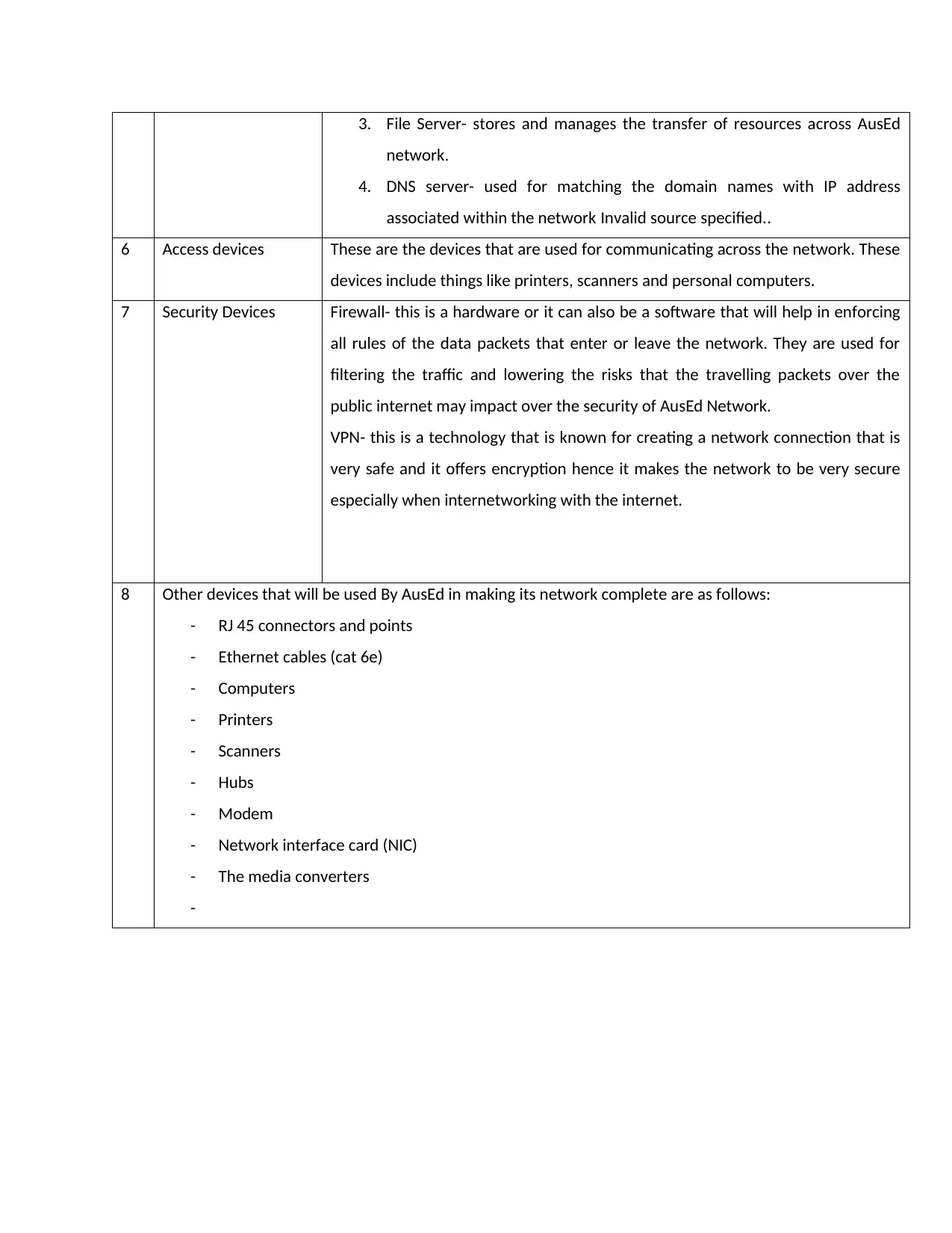
3. File Server- stores and manages the transfer of resources across AusEd
network.
4. DNS server- used for matching the domain names with IP address
associated within the network Invalid source specified..
6 Access devices These are the devices that are used for communicating across the network. These
devices include things like printers, scanners and personal computers.
7 Security Devices Firewall- this is a hardware or it can also be a software that will help in enforcing
all rules of the data packets that enter or leave the network. They are used for
filtering the traffic and lowering the risks that the travelling packets over the
public internet may impact over the security of AusEd Network.
VPN- this is a technology that is known for creating a network connection that is
very safe and it offers encryption hence it makes the network to be very secure
especially when internetworking with the internet.
8 Other devices that will be used By AusEd in making its network complete are as follows:
- RJ 45 connectors and points
- Ethernet cables (cat 6e)
- Computers
- Printers
- Scanners
- Hubs
- Modem
- Network interface card (NIC)
- The media converters
-
network.
4. DNS server- used for matching the domain names with IP address
associated within the network Invalid source specified..
6 Access devices These are the devices that are used for communicating across the network. These
devices include things like printers, scanners and personal computers.
7 Security Devices Firewall- this is a hardware or it can also be a software that will help in enforcing
all rules of the data packets that enter or leave the network. They are used for
filtering the traffic and lowering the risks that the travelling packets over the
public internet may impact over the security of AusEd Network.
VPN- this is a technology that is known for creating a network connection that is
very safe and it offers encryption hence it makes the network to be very secure
especially when internetworking with the internet.
8 Other devices that will be used By AusEd in making its network complete are as follows:
- RJ 45 connectors and points
- Ethernet cables (cat 6e)
- Computers
- Printers
- Scanners
- Hubs
- Modem
- Network interface card (NIC)
- The media converters
-
⊘ This is a preview!⊘
Do you want full access?
Subscribe today to unlock all pages.

Trusted by 1+ million students worldwide
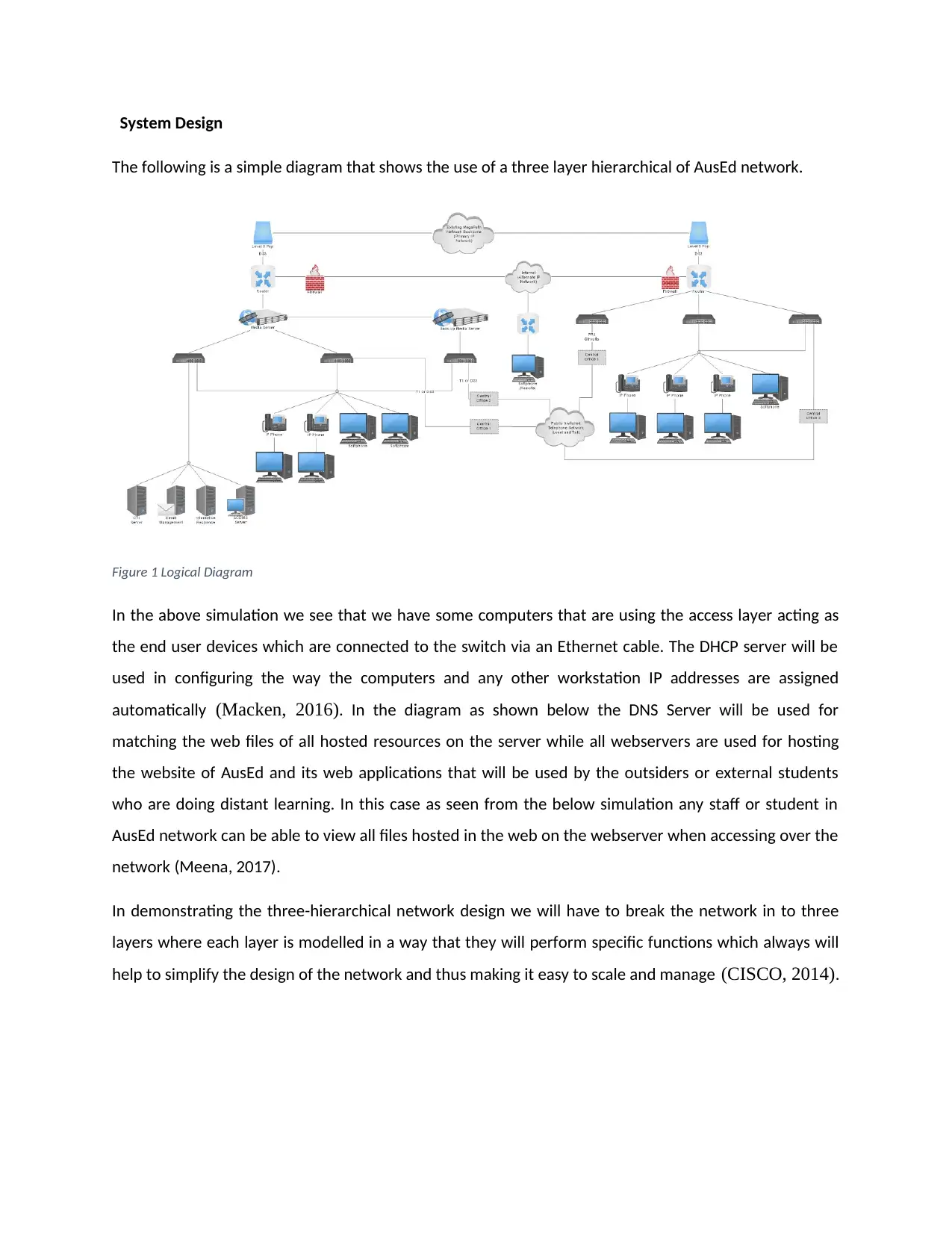
System Design
The following is a simple diagram that shows the use of a three layer hierarchical of AusEd network.
Figure 1 Logical Diagram
In the above simulation we see that we have some computers that are using the access layer acting as
the end user devices which are connected to the switch via an Ethernet cable. The DHCP server will be
used in configuring the way the computers and any other workstation IP addresses are assigned
automatically (Macken, 2016). In the diagram as shown below the DNS Server will be used for
matching the web files of all hosted resources on the server while all webservers are used for hosting
the website of AusEd and its web applications that will be used by the outsiders or external students
who are doing distant learning. In this case as seen from the below simulation any staff or student in
AusEd network can be able to view all files hosted in the web on the webserver when accessing over the
network (Meena, 2017).
In demonstrating the three-hierarchical network design we will have to break the network in to three
layers where each layer is modelled in a way that they will perform specific functions which always will
help to simplify the design of the network and thus making it easy to scale and manage (CISCO, 2014).
The following is a simple diagram that shows the use of a three layer hierarchical of AusEd network.
Figure 1 Logical Diagram
In the above simulation we see that we have some computers that are using the access layer acting as
the end user devices which are connected to the switch via an Ethernet cable. The DHCP server will be
used in configuring the way the computers and any other workstation IP addresses are assigned
automatically (Macken, 2016). In the diagram as shown below the DNS Server will be used for
matching the web files of all hosted resources on the server while all webservers are used for hosting
the website of AusEd and its web applications that will be used by the outsiders or external students
who are doing distant learning. In this case as seen from the below simulation any staff or student in
AusEd network can be able to view all files hosted in the web on the webserver when accessing over the
network (Meena, 2017).
In demonstrating the three-hierarchical network design we will have to break the network in to three
layers where each layer is modelled in a way that they will perform specific functions which always will
help to simplify the design of the network and thus making it easy to scale and manage (CISCO, 2014).
Paraphrase This Document
Need a fresh take? Get an instant paraphrase of this document with our AI Paraphraser
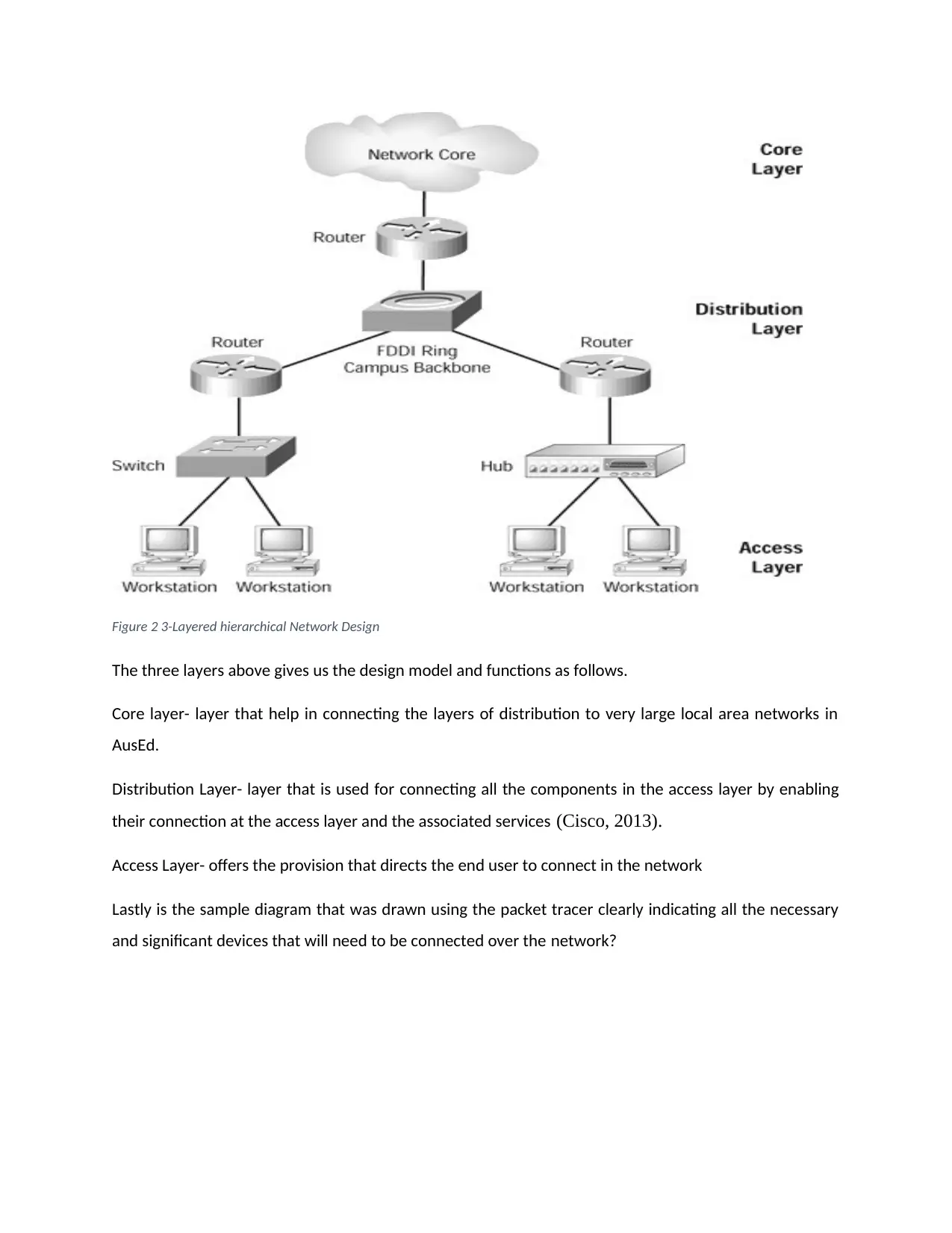
Figure 2 3-Layered hierarchical Network Design
The three layers above gives us the design model and functions as follows.
Core layer- layer that help in connecting the layers of distribution to very large local area networks in
AusEd.
Distribution Layer- layer that is used for connecting all the components in the access layer by enabling
their connection at the access layer and the associated services (Cisco, 2013).
Access Layer- offers the provision that directs the end user to connect in the network
Lastly is the sample diagram that was drawn using the packet tracer clearly indicating all the necessary
and significant devices that will need to be connected over the network?
The three layers above gives us the design model and functions as follows.
Core layer- layer that help in connecting the layers of distribution to very large local area networks in
AusEd.
Distribution Layer- layer that is used for connecting all the components in the access layer by enabling
their connection at the access layer and the associated services (Cisco, 2013).
Access Layer- offers the provision that directs the end user to connect in the network
Lastly is the sample diagram that was drawn using the packet tracer clearly indicating all the necessary
and significant devices that will need to be connected over the network?
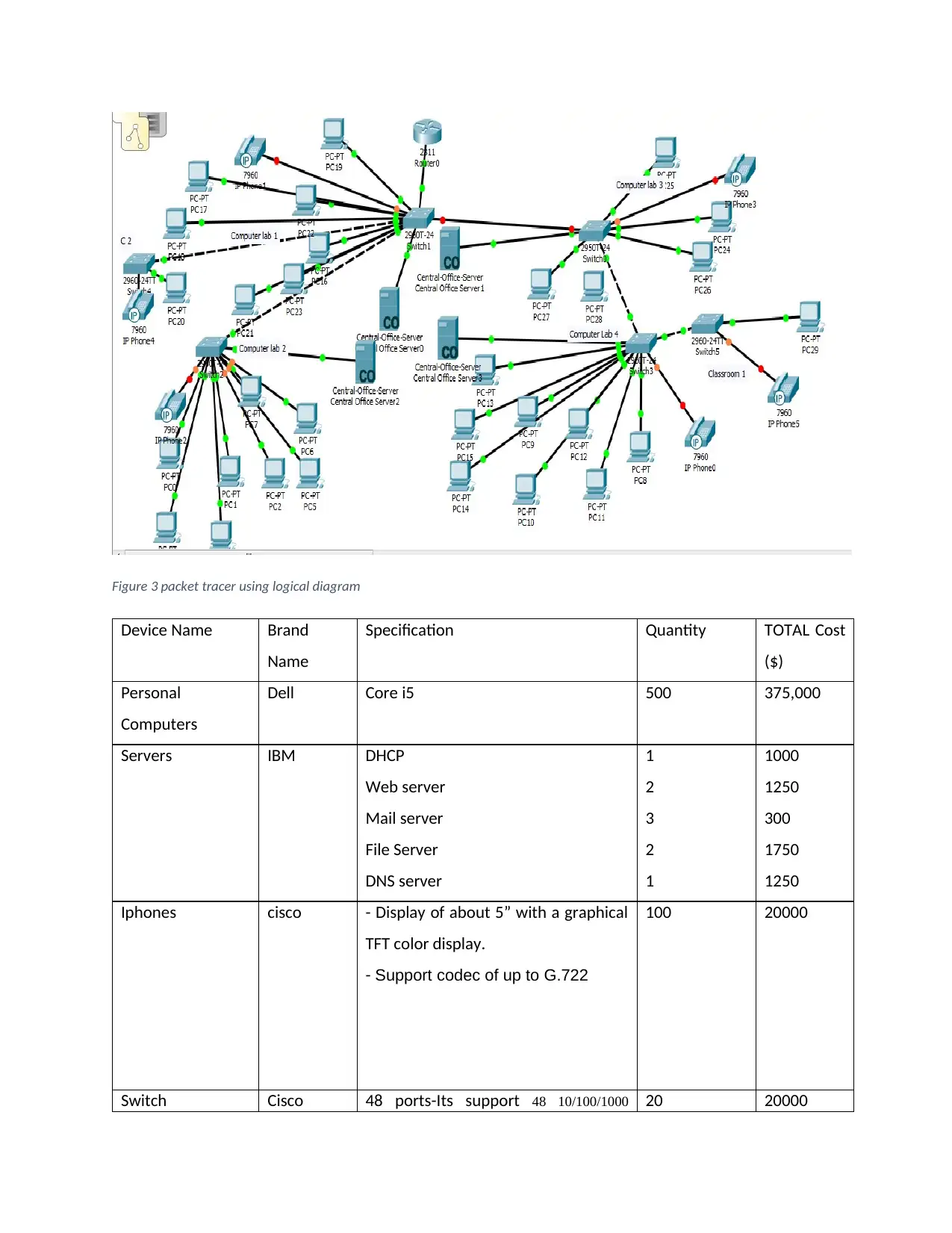
Figure 3 packet tracer using logical diagram
Device Name Brand
Name
Specification Quantity TOTAL Cost
($)
Personal
Computers
Dell Core i5 500 375,000
Servers IBM DHCP
Web server
Mail server
File Server
DNS server
1
2
3
2
1
1000
1250
300
1750
1250
Iphones cisco - Display of about 5” with a graphical
TFT color display.
- Support codec of up to G.722
100 20000
Switch Cisco 48 ports-Its support 48 10/100/1000 20 20000
Device Name Brand
Name
Specification Quantity TOTAL Cost
($)
Personal
Computers
Dell Core i5 500 375,000
Servers IBM DHCP
Web server
Mail server
File Server
DNS server
1
2
3
2
1
1000
1250
300
1750
1250
Iphones cisco - Display of about 5” with a graphical
TFT color display.
- Support codec of up to G.722
100 20000
Switch Cisco 48 ports-Its support 48 10/100/1000 20 20000
⊘ This is a preview!⊘
Do you want full access?
Subscribe today to unlock all pages.

Trusted by 1+ million students worldwide
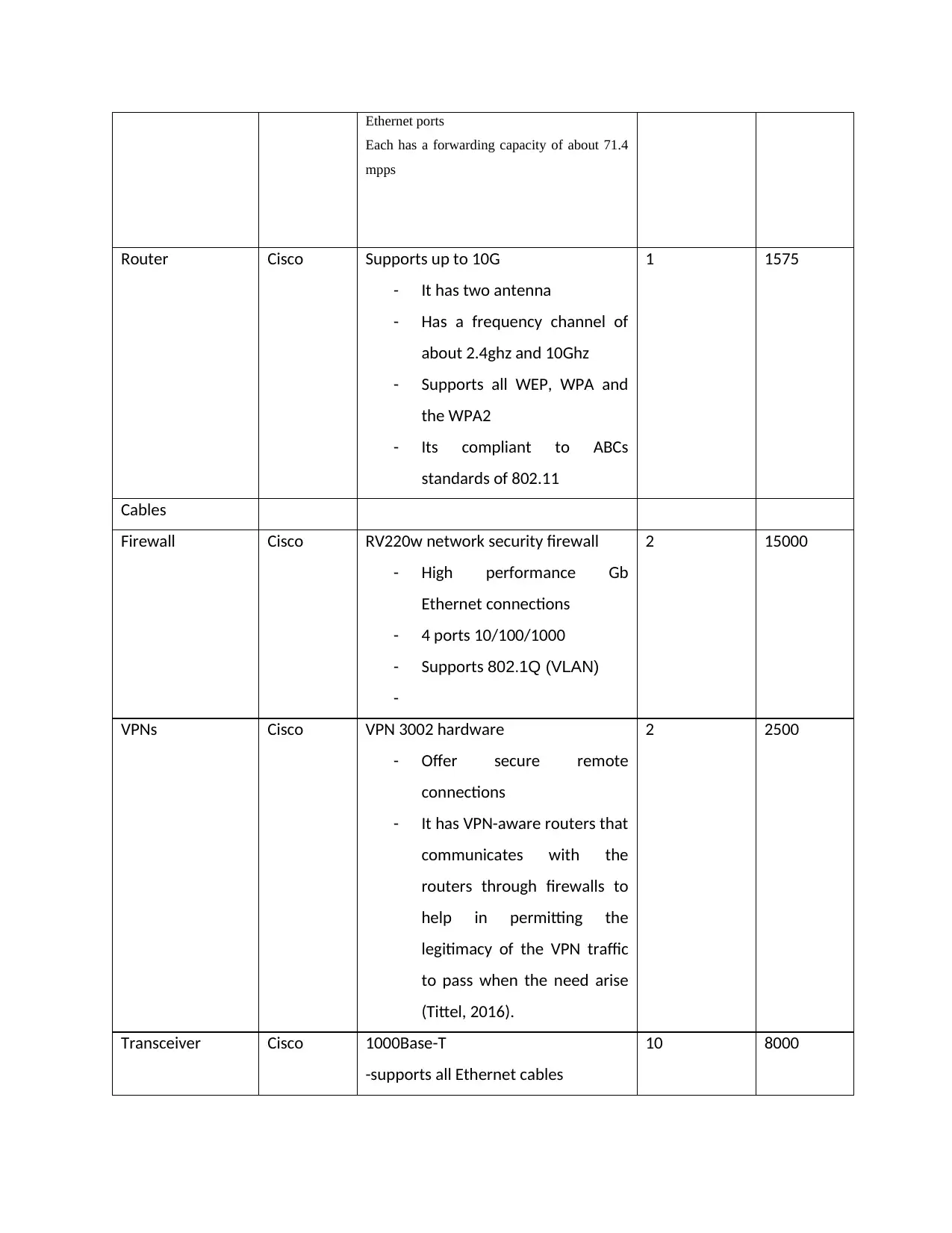
Ethernet ports
Each has a forwarding capacity of about 71.4
mpps
Router Cisco Supports up to 10G
- It has two antenna
- Has a frequency channel of
about 2.4ghz and 10Ghz
- Supports all WEP, WPA and
the WPA2
- Its compliant to ABCs
standards of 802.11
1 1575
Cables
Firewall Cisco RV220w network security firewall
- High performance Gb
Ethernet connections
- 4 ports 10/100/1000
- Supports 802.1Q (VLAN)
-
2 15000
VPNs Cisco VPN 3002 hardware
- Offer secure remote
connections
- It has VPN-aware routers that
communicates with the
routers through firewalls to
help in permitting the
legitimacy of the VPN traffic
to pass when the need arise
(Tittel, 2016).
2 2500
Transceiver Cisco 1000Base-T
-supports all Ethernet cables
10 8000
Each has a forwarding capacity of about 71.4
mpps
Router Cisco Supports up to 10G
- It has two antenna
- Has a frequency channel of
about 2.4ghz and 10Ghz
- Supports all WEP, WPA and
the WPA2
- Its compliant to ABCs
standards of 802.11
1 1575
Cables
Firewall Cisco RV220w network security firewall
- High performance Gb
Ethernet connections
- 4 ports 10/100/1000
- Supports 802.1Q (VLAN)
-
2 15000
VPNs Cisco VPN 3002 hardware
- Offer secure remote
connections
- It has VPN-aware routers that
communicates with the
routers through firewalls to
help in permitting the
legitimacy of the VPN traffic
to pass when the need arise
(Tittel, 2016).
2 2500
Transceiver Cisco 1000Base-T
-supports all Ethernet cables
10 8000
Paraphrase This Document
Need a fresh take? Get an instant paraphrase of this document with our AI Paraphraser
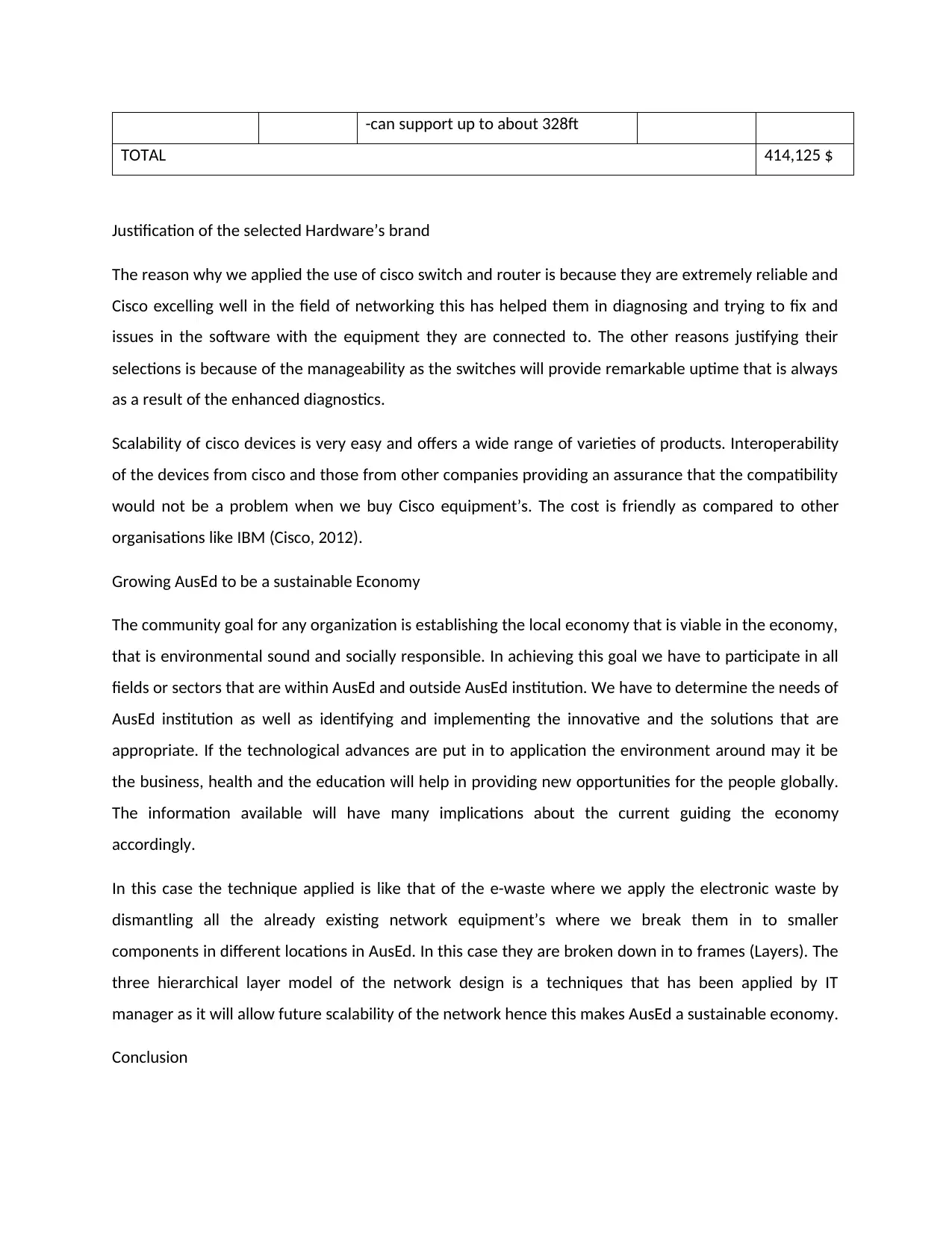
-can support up to about 328ft
TOTAL 414,125 $
Justification of the selected Hardware’s brand
The reason why we applied the use of cisco switch and router is because they are extremely reliable and
Cisco excelling well in the field of networking this has helped them in diagnosing and trying to fix and
issues in the software with the equipment they are connected to. The other reasons justifying their
selections is because of the manageability as the switches will provide remarkable uptime that is always
as a result of the enhanced diagnostics.
Scalability of cisco devices is very easy and offers a wide range of varieties of products. Interoperability
of the devices from cisco and those from other companies providing an assurance that the compatibility
would not be a problem when we buy Cisco equipment’s. The cost is friendly as compared to other
organisations like IBM (Cisco, 2012).
Growing AusEd to be a sustainable Economy
The community goal for any organization is establishing the local economy that is viable in the economy,
that is environmental sound and socially responsible. In achieving this goal we have to participate in all
fields or sectors that are within AusEd and outside AusEd institution. We have to determine the needs of
AusEd institution as well as identifying and implementing the innovative and the solutions that are
appropriate. If the technological advances are put in to application the environment around may it be
the business, health and the education will help in providing new opportunities for the people globally.
The information available will have many implications about the current guiding the economy
accordingly.
In this case the technique applied is like that of the e-waste where we apply the electronic waste by
dismantling all the already existing network equipment’s where we break them in to smaller
components in different locations in AusEd. In this case they are broken down in to frames (Layers). The
three hierarchical layer model of the network design is a techniques that has been applied by IT
manager as it will allow future scalability of the network hence this makes AusEd a sustainable economy.
Conclusion
TOTAL 414,125 $
Justification of the selected Hardware’s brand
The reason why we applied the use of cisco switch and router is because they are extremely reliable and
Cisco excelling well in the field of networking this has helped them in diagnosing and trying to fix and
issues in the software with the equipment they are connected to. The other reasons justifying their
selections is because of the manageability as the switches will provide remarkable uptime that is always
as a result of the enhanced diagnostics.
Scalability of cisco devices is very easy and offers a wide range of varieties of products. Interoperability
of the devices from cisco and those from other companies providing an assurance that the compatibility
would not be a problem when we buy Cisco equipment’s. The cost is friendly as compared to other
organisations like IBM (Cisco, 2012).
Growing AusEd to be a sustainable Economy
The community goal for any organization is establishing the local economy that is viable in the economy,
that is environmental sound and socially responsible. In achieving this goal we have to participate in all
fields or sectors that are within AusEd and outside AusEd institution. We have to determine the needs of
AusEd institution as well as identifying and implementing the innovative and the solutions that are
appropriate. If the technological advances are put in to application the environment around may it be
the business, health and the education will help in providing new opportunities for the people globally.
The information available will have many implications about the current guiding the economy
accordingly.
In this case the technique applied is like that of the e-waste where we apply the electronic waste by
dismantling all the already existing network equipment’s where we break them in to smaller
components in different locations in AusEd. In this case they are broken down in to frames (Layers). The
three hierarchical layer model of the network design is a techniques that has been applied by IT
manager as it will allow future scalability of the network hence this makes AusEd a sustainable economy.
Conclusion
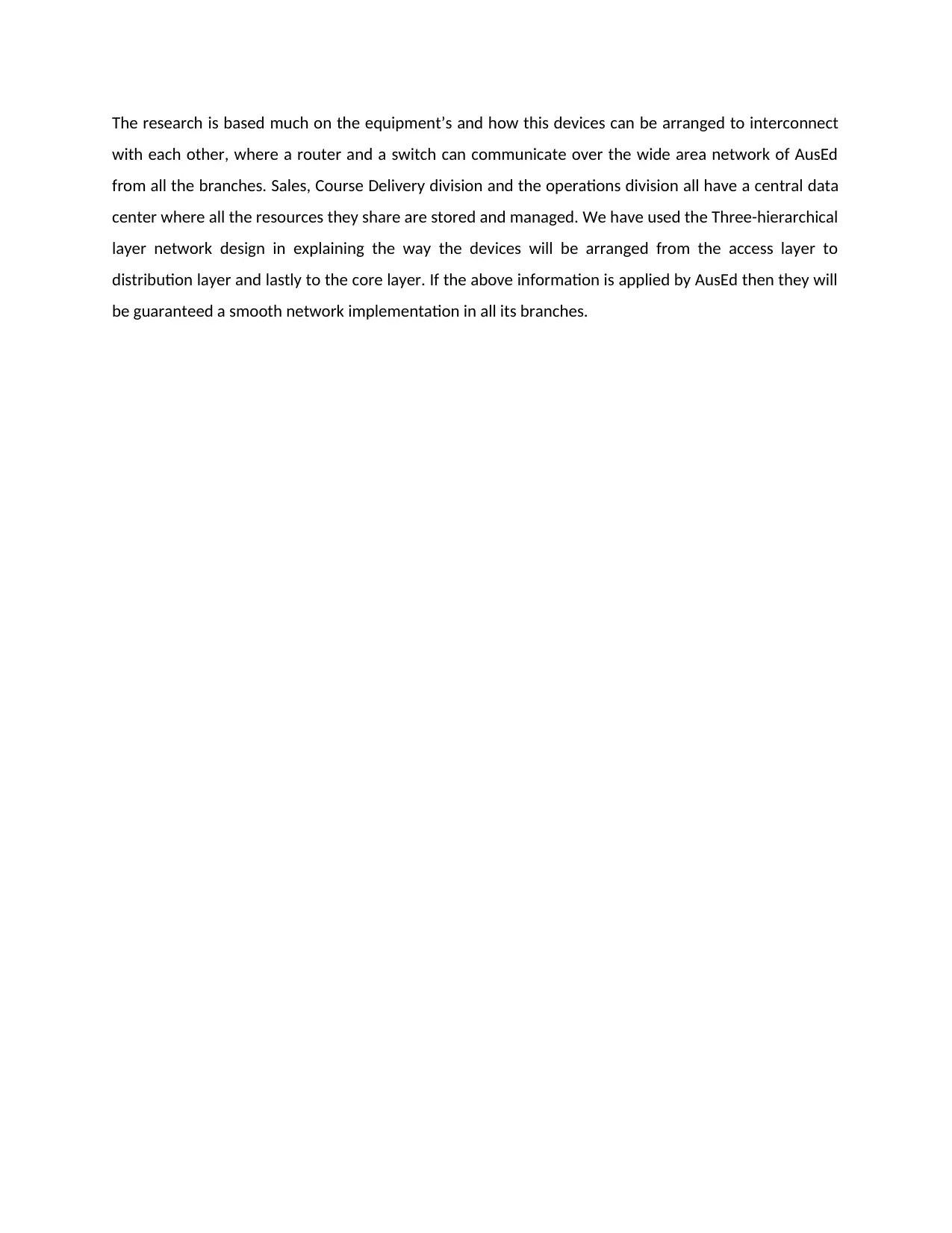
The research is based much on the equipment’s and how this devices can be arranged to interconnect
with each other, where a router and a switch can communicate over the wide area network of AusEd
from all the branches. Sales, Course Delivery division and the operations division all have a central data
center where all the resources they share are stored and managed. We have used the Three-hierarchical
layer network design in explaining the way the devices will be arranged from the access layer to
distribution layer and lastly to the core layer. If the above information is applied by AusEd then they will
be guaranteed a smooth network implementation in all its branches.
with each other, where a router and a switch can communicate over the wide area network of AusEd
from all the branches. Sales, Course Delivery division and the operations division all have a central data
center where all the resources they share are stored and managed. We have used the Three-hierarchical
layer network design in explaining the way the devices will be arranged from the access layer to
distribution layer and lastly to the core layer. If the above information is applied by AusEd then they will
be guaranteed a smooth network implementation in all its branches.
⊘ This is a preview!⊘
Do you want full access?
Subscribe today to unlock all pages.

Trusted by 1+ million students worldwide
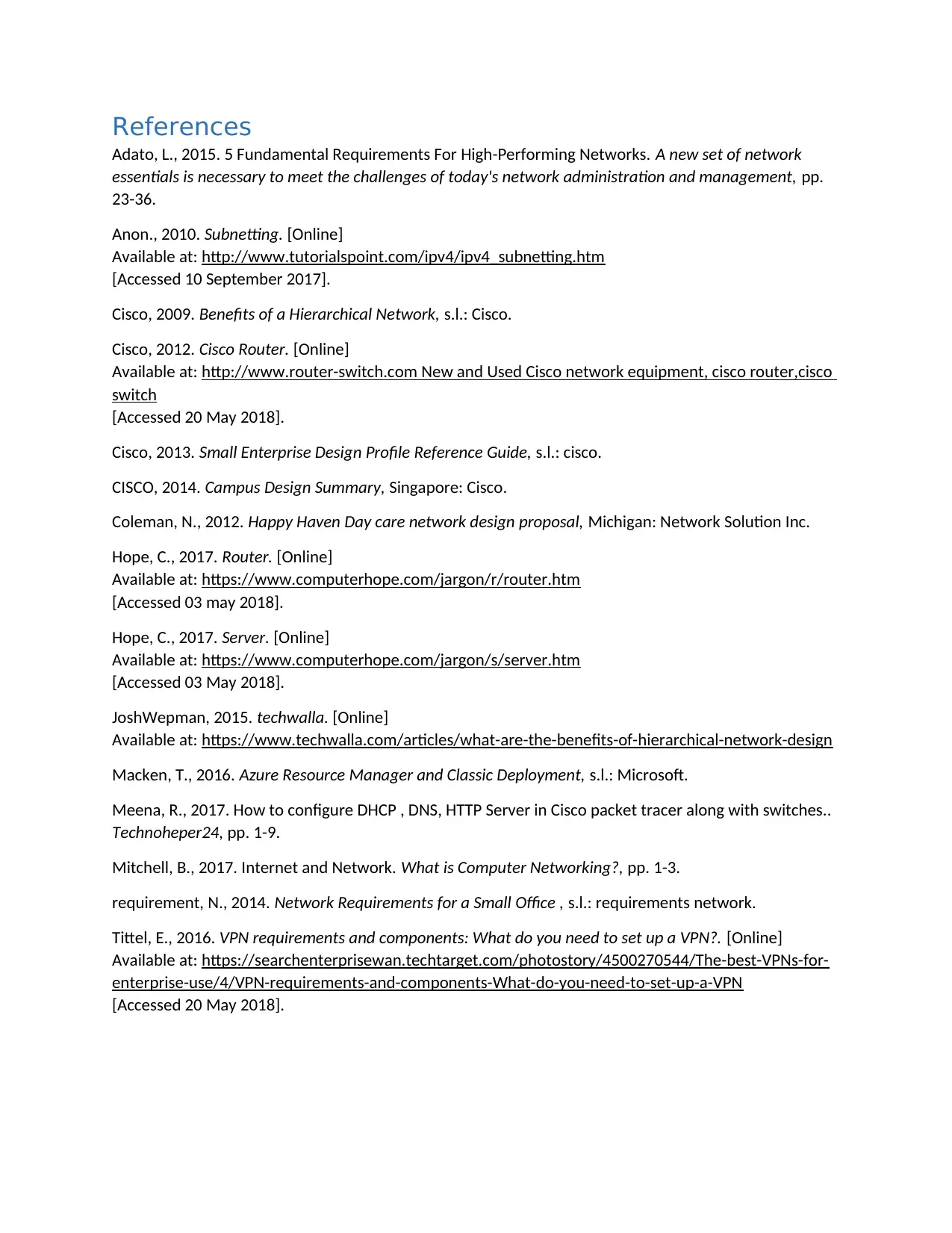
References
Adato, L., 2015. 5 Fundamental Requirements For High-Performing Networks. A new set of network
essentials is necessary to meet the challenges of today's network administration and management, pp.
23-36.
Anon., 2010. Subnetting. [Online]
Available at: http://www.tutorialspoint.com/ipv4/ipv4_subnetting.htm
[Accessed 10 September 2017].
Cisco, 2009. Benefits of a Hierarchical Network, s.l.: Cisco.
Cisco, 2012. Cisco Router. [Online]
Available at: http://www.router-switch.com New and Used Cisco network equipment, cisco router,cisco
switch
[Accessed 20 May 2018].
Cisco, 2013. Small Enterprise Design Profile Reference Guide, s.l.: cisco.
CISCO, 2014. Campus Design Summary, Singapore: Cisco.
Coleman, N., 2012. Happy Haven Day care network design proposal, Michigan: Network Solution Inc.
Hope, C., 2017. Router. [Online]
Available at: https://www.computerhope.com/jargon/r/router.htm
[Accessed 03 may 2018].
Hope, C., 2017. Server. [Online]
Available at: https://www.computerhope.com/jargon/s/server.htm
[Accessed 03 May 2018].
JoshWepman, 2015. techwalla. [Online]
Available at: https://www.techwalla.com/articles/what-are-the-benefits-of-hierarchical-network-design
Macken, T., 2016. Azure Resource Manager and Classic Deployment, s.l.: Microsoft.
Meena, R., 2017. How to configure DHCP , DNS, HTTP Server in Cisco packet tracer along with switches..
Technoheper24, pp. 1-9.
Mitchell, B., 2017. Internet and Network. What is Computer Networking?, pp. 1-3.
requirement, N., 2014. Network Requirements for a Small Office , s.l.: requirements network.
Tittel, E., 2016. VPN requirements and components: What do you need to set up a VPN?. [Online]
Available at: https://searchenterprisewan.techtarget.com/photostory/4500270544/The-best-VPNs-for-
enterprise-use/4/VPN-requirements-and-components-What-do-you-need-to-set-up-a-VPN
[Accessed 20 May 2018].
Adato, L., 2015. 5 Fundamental Requirements For High-Performing Networks. A new set of network
essentials is necessary to meet the challenges of today's network administration and management, pp.
23-36.
Anon., 2010. Subnetting. [Online]
Available at: http://www.tutorialspoint.com/ipv4/ipv4_subnetting.htm
[Accessed 10 September 2017].
Cisco, 2009. Benefits of a Hierarchical Network, s.l.: Cisco.
Cisco, 2012. Cisco Router. [Online]
Available at: http://www.router-switch.com New and Used Cisco network equipment, cisco router,cisco
switch
[Accessed 20 May 2018].
Cisco, 2013. Small Enterprise Design Profile Reference Guide, s.l.: cisco.
CISCO, 2014. Campus Design Summary, Singapore: Cisco.
Coleman, N., 2012. Happy Haven Day care network design proposal, Michigan: Network Solution Inc.
Hope, C., 2017. Router. [Online]
Available at: https://www.computerhope.com/jargon/r/router.htm
[Accessed 03 may 2018].
Hope, C., 2017. Server. [Online]
Available at: https://www.computerhope.com/jargon/s/server.htm
[Accessed 03 May 2018].
JoshWepman, 2015. techwalla. [Online]
Available at: https://www.techwalla.com/articles/what-are-the-benefits-of-hierarchical-network-design
Macken, T., 2016. Azure Resource Manager and Classic Deployment, s.l.: Microsoft.
Meena, R., 2017. How to configure DHCP , DNS, HTTP Server in Cisco packet tracer along with switches..
Technoheper24, pp. 1-9.
Mitchell, B., 2017. Internet and Network. What is Computer Networking?, pp. 1-3.
requirement, N., 2014. Network Requirements for a Small Office , s.l.: requirements network.
Tittel, E., 2016. VPN requirements and components: What do you need to set up a VPN?. [Online]
Available at: https://searchenterprisewan.techtarget.com/photostory/4500270544/The-best-VPNs-for-
enterprise-use/4/VPN-requirements-and-components-What-do-you-need-to-set-up-a-VPN
[Accessed 20 May 2018].
Paraphrase This Document
Need a fresh take? Get an instant paraphrase of this document with our AI Paraphraser

1 out of 11
Related Documents
Your All-in-One AI-Powered Toolkit for Academic Success.
+13062052269
info@desklib.com
Available 24*7 on WhatsApp / Email
![[object Object]](/_next/static/media/star-bottom.7253800d.svg)
Unlock your academic potential
Copyright © 2020–2025 A2Z Services. All Rights Reserved. Developed and managed by ZUCOL.





